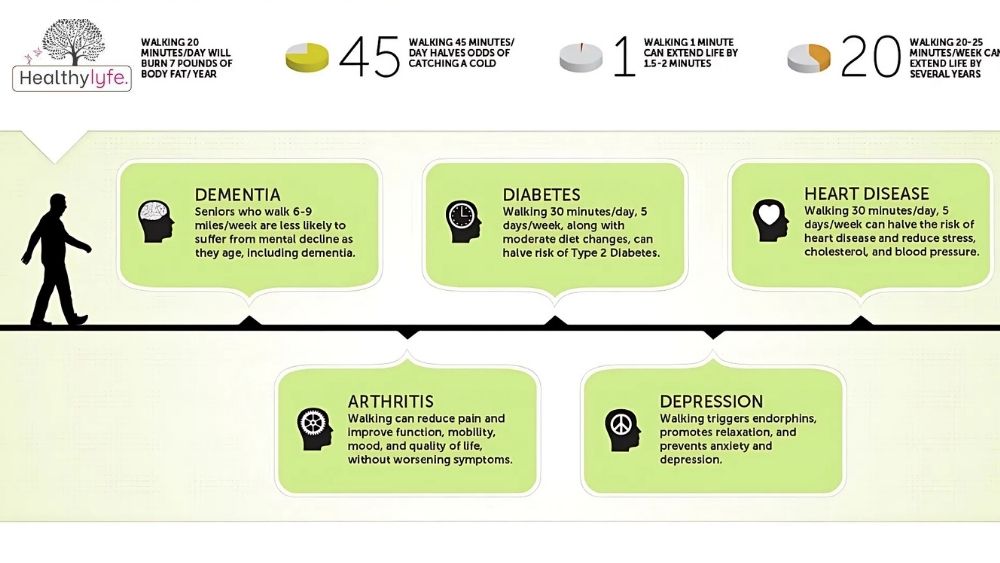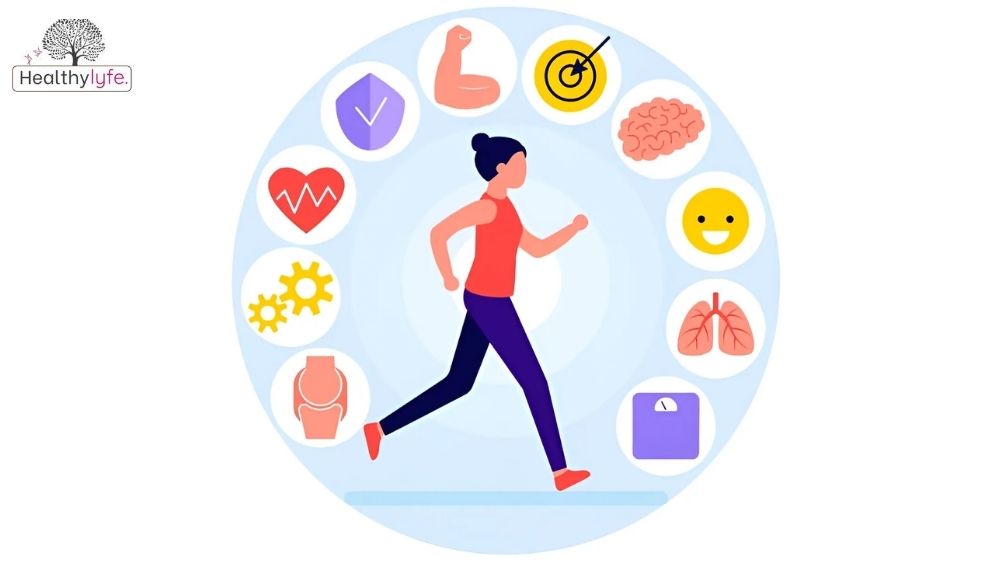The benefits of walking or running for your health. Learn which activity suits your fitness goals, lifestyle, and overall well-being best.
Introduction
Walking and running are two of the most popular ways to stay active and healthy. Both are easy to do and don’t require special equipment, making them great for anyone looking to get moving. But which one is better for your health? In this article, we’ll break down the benefits of walking and running to help you decide which suits your fitness goals and lifestyle best.
Common debate: walking vs. running [1]
Walking and running are two of the simplest and most effective ways to stay active, but the question of which is better often sparks debate. Walking is a low-impact, steady-paced activity that’s easy on the joints, while running offers a higher-intensity workout with greater calorie burn. Each has unique benefits, and the best choice often depends on your fitness goals, physical condition, and personal preferences. Let’s explore the pros and cons of both to help you make an informed decision.
Benefits of Walking
Walking is a simple yet powerful way to improve your health and well-being. It’s an accessible form of exercise suitable for people of all ages and fitness levels. Whether you’re looking to boost your mood, maintain a healthy weight, or simply stay active, walking offers numerous advantages. Here are five key benefits of incorporating walking into your daily routine:

- Improves Heart Health
Walking is an excellent cardiovascular exercise that helps strengthen the heart and improve circulation. Regular walking can lower blood pressure, reduce bad cholesterol (LDL), and increase good cholesterol (HDL), decreasing the risk of heart disease. - Supports Joint Health
Walking is a low-impact activity that’s gentle on the joints while promoting flexibility and strength. It can reduce the risk of arthritis and help alleviate joint pain by improving circulation to the cartilage and muscles. - Boosts Mental Health
A daily walk can work wonders for your mental well-being. Walking stimulates the release of endorphins, which improve mood and reduce stress, anxiety, and symptoms of depression. Spending time outdoors while walking enhances these effects even further. - Aids in Weight Management
Walking helps burn calories and supports weight loss or maintenance goals. Even a brisk 30-minute walk each day can make a significant difference, especially when combined with a balanced diet. - Enhances Overall Fitness
Regular walking increases stamina, strengthens muscles, and improves balance and coordination. It’s an effective way to build a solid foundation for overall fitness, making it easier to take on more vigorous activities in the future.
Benefits of Running
Running is one of the most effective and accessible forms of exercise, offering a wide range of health benefits for both the body and mind. Whether you’re a seasoned marathon runner or just starting, the rewards of running go beyond weight management and physical fitness. Here are five key benefits of running that make it a powerful activity for improving overall well-being.
- Boosts Cardiovascular Health
Running strengthens the heart and improves circulation, reducing the risk of heart disease and high blood pressure. Regular running helps lower bad cholesterol and maintain a healthy heart. - Burns Calories and Supports Weight Loss
Running is a high-intensity exercise that burns more calories than many other activities. It helps boost metabolism, making it a great choice for those looking to shed or maintain weight. - Enhances Mental Health
Running releases endorphins, often referred to as “feel-good” hormones, which help reduce stress, anxiety, and depression. Many runners also find mental clarity and relaxation during their runs. - Strengthens Muscles and Bones
Running helps build strong leg muscles and improves bone density, reducing the risk of osteoporosis as you age. It’s an excellent way to keep your lower body strong and resilient. - Improves Stamina and Endurance
Regular running increases lung capacity and overall stamina, making it easier to perform daily activities and other physical tasks. Over time, you’ll notice greater energy levels and improved endurance.
Impact on Joints and Injury Risk
Running is a great workout, but it can put extra stress on your joints, especially the knees, hips, and ankles. While it offers many health benefits, it’s important to understand the risks and how to avoid injuries.
- Stress on Joints
The repetitive motion of running can strain your joints over time, particularly if you have poor form or pre-existing joint issues. - Common Injuries
Problems like runner’s knee, shin splints, and stress fractures are often caused by overuse or not taking enough rest between runs. - What Increases the Risk
Factors like age, weight, wearing the wrong shoes, or running on hard surfaces can make joint stress and injuries more likely. - How to Stay Safe
Warm up before running, wear proper shoes, strengthen your muscles, and gradually increase your running distance to lower the risk of injuries. - Low-Impact Options
If running is hard on your joints, activities like walking, swimming, or cycling can provide similar health benefits with less strain.
Assessing Your Health Goals
Choosing between walking and running starts with understanding your health goals. Both activities offer unique benefits, but the right choice depends on what you aim to achieve. Here’s how to align your fitness routine with your objectives:

- Weight Loss
If burning calories quickly is your priority, running is more effective due to its higher intensity. However, walking can still help with weight loss when done consistently over longer periods. - Improving Heart Health
Both walking and running boost cardiovascular health, but running provides a more intense workout for strengthening the heart and improving endurance. Walking is a great option for those who prefer a gentler pace. - Building Endurance
Running is ideal for increasing stamina and lung capacity. However, if you’re new to exercise, walking is a good starting point to build endurance gradually. - Low-Impact Fitness
For those with joint concerns or recovering from an injury, walking is a safer, low-impact choice that still offers health benefits. - Mental Well-Being
Both walking and running can reduce stress and improve mood, but the choice often depends on what feels more enjoyable and manageable for you.
Choosing the Right Activity for Your Goals
When it comes to staying active, the best exercise is the one that fits your goals, lifestyle, and preferences. Walking and running each offer unique benefits, and your choice should depend on what works best for your body and schedule. Whether you’re aiming to improve fitness, lose weight, or simply enjoy movement, understanding your needs can help you decide which activity is right for you.
Calorie Burn
When comparing calorie burn, running typically outpaces walking due to its higher intensity. On average, running burns about twice as many calories as walking over the same distance.
- Calories Burned While Running
A 150-pound person can burn around 600 calories per hour running at a moderate pace of 5 miles per hour. - Calories Burned While Walking
The same person would burn approximately 300 calories per hour walking briskly at a pace of 3.5 miles per hour. - Why the Difference?
Running requires more energy because it engages more muscles, involves higher impact, and demands greater effort to propel the body forward. - Distance Matters
Interestingly, calorie burn for walking and running over the same distance (not time) is closer, but running still has a slight edge due to its intensity. - Choose What Works for You
While running burns more calories, walking is easier on the joints and can be done for longer periods, making it a great option for sustained exercise.
Weight Loss
Walking at a steady pace may not burn as many calories as running in the short term, but it can still contribute to significant weight loss over time. Consistency and duration are key to making walking an effective part of your weight loss journey.
- Calorie Burn Adds Up
A brisk walk for 30-60 minutes a day can burn 150-300 calories, depending on your weight and speed. Over weeks and months, this can lead to noticeable weight loss. - Easier to Sustain
Walking is low-impact and less tiring than running, making it easier to stick to a daily routine, which is essential for long-term results. - Supports Fat Burning
Walking at a moderate pace keeps your body in a fat-burning zone, where a higher percentage of calories burned comes from fat rather than carbohydrates. - Boosts Metabolism
Regular walking can improve your metabolism and help maintain muscle mass, supporting long-term weight management. - Pairs Well with Healthy Habits
Combined with a balanced diet and strength training, walking can be a powerful tool for achieving and maintaining a healthy weight.
Tips for Success
Whether you prefer walking, running, or a mix of both, the right approach can help you stay consistent, avoid injuries, and achieve your fitness goals. Here are some tips for success:
Set Realistic Goals
- Start with small, achievable milestones, such as walking 20 minutes daily or running 1 mile without stopping.
- Gradually increase time, distance, or intensity to stay motivated.
Wear the Right Shoes
- Invest in comfortable, supportive shoes designed for walking or running to prevent discomfort and injuries.
Warm Up and Cool Down
- Always begin with a 5-10 minute warm-up to prepare your muscles.
- End with stretches to improve flexibility and reduce soreness.
Stay Hydrated
- Drink water before, during, and after your walk or run to stay hydrated and energized.
Listen to Your Body
- Pay attention to signs of fatigue, pain, or discomfort. Rest when needed to avoid overtraining or injuries.
Mix It Up
- Alternate between walking and running for variety and to challenge your body.
- Add intervals, such as jogging for 2 minutes during a walk, to increase calorie burn and build endurance.
Find a Routine You Enjoy
- Choose scenic routes, listen to music, or invite a friend to make your activity more enjoyable.
Track Your Progress
- Use fitness apps or wearable devices to monitor steps, distance, and calories burned.
- Celebrate milestones to stay motivated.
Incorporate Rest Days
- Schedule rest or low-intensity days to allow your body to recover and prevent burnout.
Combine with Strength Training
- Add strength exercises to your routine to build muscle, improve joint health, and enhance overall fitness.
Conclusion
Walking and running are both great ways to stay active and healthy. Walking is easier on the joints and perfect for beginners, while running burns more calories and improves fitness faster. The best choice depends on your goals and preferences. If you want a low-impact, steady workout, walking is ideal. If you’re looking for a quick calorie burn and a higher-intensity challenge, running may be better.
FAQs about Walking and Running
Is walking as effective as running?
Walking can provide similar health benefits to running if done for a longer duration, though running burns more calories in less time.
How many steps should I walk daily for health benefits?
The standard recommendation is 10,000 steps per day, but even 7,000 steps have been shown to significantly improve health.
What is a brisk walking pace?
A brisk pace is around 3–4 mph or when your heart rate increases, and you feel slightly out of breath but can still hold a conversation.
Can walking reduce belly fat?
Yes, walking regularly combined with a healthy diet can help reduce overall body fat, including belly fat.
What are the best shoes for walking?
Shoes with good arch support, cushioning, and a flexible sole are ideal for walking.
How long should I walk each day?
Walking 30 minutes daily is a good goal, but even shorter durations can benefit your health.
Can I lose weight by walking?
Yes, walking can help with weight loss if combined with a calorie-controlled diet.
Is walking good for mental health?
Absolutely. Walking, especially in nature, can reduce stress, anxiety, and symptoms of depression.
What are the benefits of walking after meals?
Walking after meals can improve digestion and help regulate blood sugar levels.
How can I make walking more challenging?
Increase your speed, add inclines or stairs, use weights, or try interval walking.
Is running every day safe?
Running daily can lead to overuse injuries; it’s best to allow rest days for recovery.
How many calories does running burn?
Running burns approximately 100 calories per mile, depending on weight, pace, and terrain.
What is the ideal running form?
Maintain an upright posture, a slight forward lean, relaxed arms at a 90-degree angle, and a midfoot strike.
How do I prevent running injuries?
Warm-up properly, increase mileage gradually, wear proper shoes, and cross-train.
Is it better to run on a treadmill or outside?
Both have benefits. Treadmills are easier on joints, while outdoor running improves balance and engages more muscles.
How can I run faster?
Incorporate interval training, strength exercises, and consistent practice into your routine.
What should I eat before running?
Eat a small snack like a banana, toast, or an energy bar 30–60 minutes before running.
How do I stay hydrated while running?
Drink water before, during, and after runs. For long runs, consider sports drinks for electrolytes.
Can running improve mental health?
Yes, running releases endorphins, reduces stress, and can alleviate symptoms of anxiety and depression.
What gear do I need for running?
Proper running shoes, moisture-wicking clothes, a running watch, and reflective gear for nighttime runs.
By healthylyfe


